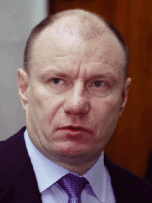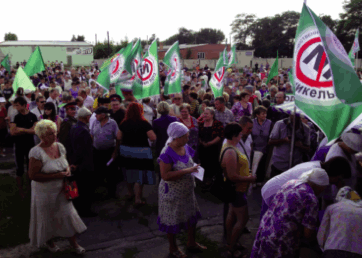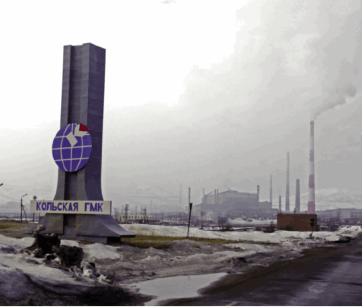Something happened on the road to the Voronezh project; environmental activists backed by Putin convinced Russian nickel miners to clean up their act
MMC Norilsk Nickel, the largest mining company in Russia and one of the world’s largest nonferrous base-metal miners, faces very serious pressure from the community and Russian environmental protection organizations. They claim that the company’s activity harms the health of surrounding citizens and nature. These pressures combined with weaker prices for metals are raising future performance standards for the company.
In terms of total world production, Norilsk Nickel mines palladium (41%), nickel (17%), platinum (11%), cobalt (10%, concentrate) and copper (2%). Domestically, the company accounts for all of the platinum production, most of the nickel (96%), cobalt (95%) and a majority of the copper (55%). As an industrial leader, it plays a crucial role in the Russian economy, accounting for about 4.3% of all Russian exports, 1.9% of GDP, 2.8% of total industrial output and 27.9% of output of the non-ferrous metallurgy industry.
Recently Norilsk Nickel updated its development strategy, which, as confirmed by top management, dramatically changes its course for the coming years. The primary focus of development in accordance with the new plan will be on large assets, possibly including Voronezh, the last large non-developed nickel deposit in Europe. This project probably will be implemented jointly with the other Russian nickel-mining company, UMMC. During the tender process, it was selected over Norilsk Nickel, but has since proposed a joint venture to develop this deposit. Implementation, however, was halted for a while because of mass public protests. Some residents of Voronezh believe that the proposed processing facilities will be harmful to the surrounding environment.
Environmental groups opposing the project cite the results of recent studies that show that Norilsk has become the most polluted city in the world during the last 20 years. They claim the incidence of cancer is more than twice the national average for Russians (for some cancer there is more than eight times higher than the national average). The Voronezh protests became so active that the prospects for developing the deposit are unclear.

Norilsk Nickel’s Polar Division mines 16.5 million mt/y of ore and produces 124,000 mt/y nickel.
Charting a New Course
During October 2013 the Norilsk Nickel board of directors approved a new development strategy, which is very different from previous programs. The previous strategy, approved in October 2011, was canceled because of the significant drop in nickel prices.
Three years ago Norilsk Nickel was going to become a diversified mining company, according to statements re- leased by the company. The 2011 plan allocated $37.6 billion of investment through 2025, including $10.9 billion directed toward developing a resource base. At the time, the company thought this investment would propel its status to one of the five largest by market capitalization, doubling earnings compared to 2010 to $14.3 billion, and increasing the level of ore mining at the Russian mines by 150%.
“It was a production plan developed with little regard to the volatility of the market conditions,” said Pavel Fedorov, deputy director of Norilsk Nickel. “It should have withstood the most severe stress tests, including those that the market has faced in 2013: a 30% drop of prices for nickel.”
“Our company should become more modern, but it currently operates the same as some old Ministry of the Soviet Union,” said Vladimir Potanin, chairman and CEO of Norilsk Nickel. “Now we want to move away from massive 15-year development plans.”
A difficult market situation has forced Norilsk Nickel to abandon the previous plan and to create a new one. Now the company will focus on “prime assets,” or its largest mines. The document adopted by the heads of the company provides criteria with which the enterprises should comply to be included in the list of prime assets. In particular the revenue of such enterprises should exceed $1 billion; the profit margin (EBITDA) should be higher than 40%, while ore reserves should be enough to support mining for more than 20 years. The company’s Polar Branch (Taimyr Peninsula), which has been operating since 1939, is the only one that meets all these requirements. In 2012, the branch produced 124,000 metric tons (mt) of nickel, while the total level of mining of the group has been amounted to 300,340 mt.
Industry experts say that it is hard to predict whether the Kolskay MMC unit will be able to comply with the new criteria. The revenue of this asset is more than $1 billion, but EBITDA margin is below 40% and the reserves are not well understood.
The future of the Trans-Baikalian assets is also unclear. There are enough reserves to support production for more than 20 years, but this enterprise will probably not be able to provide revenues of $1 billion.
Norilsk Nickel will likely sell all the assets that do not match the new criteria during the next three years. The heads of the company also confirm that with the new development strategy Norilsk Nickel will fully focus on its Russian mines. Thus, Norilsk Nickel confirmed that it is currently seeking investors and is ready to sell all of its foreign assets during 2013-2014.

Pavel Federov, deputy director, Norilsk Nickel.

Vladimir Potanin, chairman and CEO, Norilsk Nickel.
“One of the main objectives for management is improving efficiency,” Fedorov said. “If the company is profitable it will not only sell final products, but byproducts as well, such as copper and possibly nickel concentrate. A surplus of metals and weak prices will yield a very low return on capital. These installations consume large amounts of power and concentrate sales during the last 10 to 15 years has increased and adds liquidity.”
Fedorov emphasized that this approach does not reduce metal production capacities for the company, but it does define the philosophy of making new investment decisions as far as increasing the level of output at the mines.
According to industry experts, the main goal of the company according to the new program remains the same. Three years ago Norilsk Nickel planned to increase the proportion of copper and platinum group metals in the structure of the revenue. In 2012, the revenue of the company was $11.1 billion, of which 47% was attributed to nickel sales, 26% for copper sales, 16% for palladium, 9% for platinum and 2% for gold. “The greatest interest will be in how the new strategy will balance ambitious growth and the need for diversification, which requires substantial capital investments, with the interests of shareholders,” Denis Perevezentsev, a Moody’s Vice President and lead analyst for Norilsk Nickel.
Speaking about the interest of the shareholders, it is noteworthy that according to the agreement between the major shareholders: Interros (Vladimir Potanin), UC Rusal (Oleg Deripaska) and Millhouse (Roman and Alexander Abramov) the company in 2013 must pay $3 billion of dividends, and the same amount will be kept for 2014, while after that it should pay the half of EBITDA, so in fact the volume of dividends will sustainably rise—at least to $4 billion which may decrease the investment capabilities of the company in operational activities.
“Norilsk Nickel is a unique company that has sufficient resources to provide full funding for the necessary investments and agreed level of dividends,” said Maxim Sokov, a Norilsk Nickel board member.
“We intend to significantly increase the production of platinum group metals and copper and maintain a stable level of nickel production,” said Sergey Dyachenko, deputy director-operations for Norilsk Nickel.
According to the program, the increase in production will come primarily from the Polar Branch, which will increase to 18.5-19 million mt per year by 2018. “Our capital expenditures will focus mainly, if not entirely, on our Polar Branch,” Fedorov said.
According to the plans, annual nickel production is expected to increase from 229,000 mt in 2013 up to 230,000-240,000 mt by 2016. By 2018, it will grow to 225,000-235,000 mt. Platinum production is planned to rise from 626,000 oz in 2013 to 615,000-640,000 oz in 2016 and up to 665,000-690,000 oz in 2018. Palladium production will grow from 2.58 million oz in 2013 to 2.53-2.63 million oz in 2016 and then to 2.73-2.84 million oz in 2018. Copper output will grow from 358,000 mt in 2013 to 360,000-375,000 mt in 2016 and to 380,000-400,000 mt in 2018. How- ever, if the company implements its plans to develop the Trans-Baikal region the production of copper in 2018 could rise to 420,000-445,000 mt per year, according to the presentation.
One of the most important parts of the future investment plan is the allocation of the funds aimed to make all mining more environmental friendly.
Environmental Friendly Modernization
The company has repeatedly noted that it pays a lot of attention to the use of environmentally safety technologies and spares no expense to these tasks. In the last three years, the company claims it has allocated $1.4 billion for environmental measures.

Protestors rally against the proposed Voronezh project.
“Norilsk Nickel is working in line with global trends of the major manufacturers in our industry, in the face of growing demands from the state and public organizations to the environmental issues,” said Dyachenko. “Our science and technology programs will enable us to meet standards we once thought were impossible to achieve.”
“Now the company is undergoing another revision of the long-term strategy of the development of all departments and so we will continue to focus on environmental issues, as this is our responsibility, and it will be the significant component of our future investments,” Dyachenko said.
The main areas of the environmental program were still under discussion at the end of 2013.
Currently the government of the Krasnoyarsk Krai, which includes Norilsk, by order of Vladimir Putin, President of the Russian Federation, is preparing a program for reducing the negative impact of local businesses to the environment, which should “help” Norilsk Nickel reach its environmental goals.
The Polar Division has already initiated the implementation of a modernization program, which has two main goals: to create a more environmentally friendly business and to make the work of the enterprise more effective. “The modernization of the Polar Division will involve several directions,” said Alexander Rumin, director of the Polar Division. “On the one hand it will modernize production facilities, develop mining areas and maintain retired capacities. On the other hand it is, of course, improving the impact of the mining enterprise on the environment.”
The plan calls for the upgrading of the equipment at the Taimyrsky mine and the construction of the deepest shaft in Russia at the Skalisty mine. The company also will make improvements to the Talnakhskaya, Medni and Nadezhda processing plants, reducing emissions by 99%. The cost of the project is about $33 million.
“By the end of this decade, we hope that the environment problems [in Norilsk] will be almost completely resolved,” said Potanin. “The technology for capture of these gases does not, in fact, currently exist, so we are in effect running an experiment. This explains why we act so consistently. If the technology proves to be effective, it will be distributed to all of our mines. We expect that by the time of completion of this program, the environmental situation in Norilsk will change dramatically.”
The Medni mine has already installed Latham pressure filters. According to the company, the new filters capture more than 1,000 mt of copper cathode, more than 20 mt of nickel cathode and 70 kg of platinum group metals per year.
The second major project is improving the disposal of acidic effluents in the Murmansk region. The object is to neutralize the negative effect of nickel production on the ecosystem adjacent to the industrial area of Kola in Monchegorsk.
The project is based on a unique technology of complete evaporation of acidic effluents, i.e. liquid waste resulting from the use of chemicals in the production of electrolytic nickel. The evaporation process produces distilled water and converts harmful chemicals (sodium sulphate and sodium chloride) to commercial byproducts. After project implementation sodium chloride and boron emissions will be reduced to zero, with sodium sulphate emissions reduced by almost four times.
“Norilsk Nickel consistently introduces advanced environmental technologies,” said Evgeny Yakovlev, the First Deputy General Director, Norilsk Nickel. “The acidic effluent disposal project implemented at Kola MMC is as unique for Russia as sulfur dioxide disposal project launched by the Polar Division. Solving environmental problems in the regions of operation and minimizing the environmental impact is a key priority, and we are performing this work.”
Construction is already under way. The total cost of the project will amount to approximately $28.4 million. The company plans to implement the project within 2 years.
However, according to Blacksmith Institute, Norilsk is one of the most polluted cities in the world, while Russian Federal Statistic Services reported that it is the most polluted city in Russia. Despites all efforts of the company today the environmental situation in Norilsk is bad. Air pollution in Norilsk is significant and unhealthy. According to Russian environmentalists, Norilsk is an environmental disaster zone.
Norilsk residents regularly complain of breathing difficulties caused by the toxic smell in the air. Among the city’s population greatly increased the rate of spread for allergies, asthma, congenital abnormalities of the cardiovascular system, respiratory system and digestive system, blood disorders, mental disorders, even among children.

The Kola MMC division mines 8.1 million mt of ore and produces 113,000 mt nickel.
The Voronezh Project
A large amount of public attention in Russia has been recently attracted by the proposal to develop Voronezh project, which includes the Elanskyand Elkinskoe deposits—the last major copper-nickel deposits in Europe.
While there is enormous metallurgical potential, Voronezh is located in the territory of Black Earth—the main agricultural region of Russia with one of the best ecological conditions. The proposed implementation of the project resulted in large public protests.
In response to the public protests, representatives of the project claim that during its implementation the companies will use only the most advanced and environmental friendly technology which will not let any negative impact of mining and ore processing on the nature.
The regional authorities also promised the public that they would monitor the project and conduct all necessary checks and inspections to make sure that the enterprises of the mining complex really do no harm to nature. The voices of opposition from the Voronezh region have raised the bar for environment friendly technology at Russian nickel mines.









